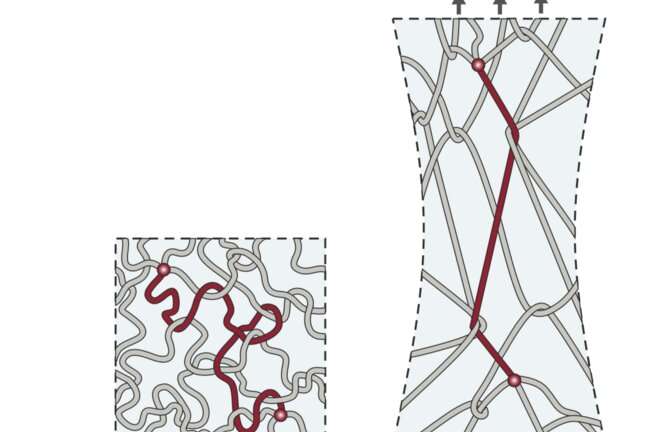Elastic polymer that is both stiff and tough, resolves long-standing quandary

Polymer science has made possible rubber tires, Teflon and Kevlar, plastic water bottles, nylon jackets among many other ubiquitous features of daily life. Elastic polymers, known as elastomers, can be stretched and released repeatedly and are used in applications such as gloves and heart valves, where they need to last a long time without tearing. But a conundrum has long stumped polymer scientists: Elastic polymers can be stiff, or they can be tough, but they can’t be both.
This stiffness-toughness conflict is a challenge for scientists developing polymers that could be used in applications including tissue regeneration, bioadhesives, bioprinting, wearable electronics, and soft robots.
In a paper published today in Science, researchers from the Harvard John A. Paulson School of Engineering and Applied Sciences (SEAS) have resolved that long-standing conflict and developed an elastomer that is both stiff and tough.
“In addition to developing polymers for emerging applications, scientists are facing an urgent challenge: Plastic pollution,” said Zhigang Suo, the Allen E. and Marilyn M. Puckett Professor of Mechanics and Materials, the senior author of the study. “The development of biodegradable polymers has once again brought us back to fundamental questions—why are some polymers tough, but others brittle? How do we make polymers resist tearing under repeated stretching?”
Polymer chains are made by linking together monomer building blocks. To make a material elastic, the polymer chains are crosslinked by covalent bonds. The more crosslinks, the shorter the polymer chains and the stiffer the material.
“As your polymer chains become shorter, the energy you can store in the material becomes less and the material becomes brittle,” said Junsoo Kim, a graduate student at SEAS and co-first author of the paper. “If you have only a few crosslinks, the chains are longer, and the material is tough but it’s too squishy to be useful.”
To develop a polymer that is both stiff and tough, the researchers looked to physical, rather than chemical bonds to link the polymer chains. These physical bonds, called entanglements, have been known in the field for almost as long as polymer science has existed, but they’ve been thought to only impact stiffness, not toughness.
But the SEAS research team found that with enough entanglements, a polymer could become tough without compromising stiffness. To create highly entangled polymers, the researchers used a concentrated monomer precursor solution with 10 times less water than other polymer recipes.

“By crowding all the monomers into this solution with less water and then polymerizing it, we forced them to be entangled, like tangled strings of yarn,” said Guogao Zhang, a postdoctoral fellow at SEAS and co-first author the paper. “Just like with knitted fabrics, the polymers maintain their connection with one another by being physically intertwined.”
With hundreds of these entanglements, just a handful of chemical crosslinks are required to keep the polymer stable.
“As elastomers, these polymers have high toughness, strength, and fatigue resistance,” said Meixuanzi Shi, a visiting scholar at SEAS and co-author of the paper. “When the polymers are submerged in water to become hydrogels, they have low friction, and high wear resistance.”
That high fatigued resistance and high wear resistance increases the durability and lifespan of the polymers.
“Our research shows that by using entanglements rather than crosslinks, we could decrease the consumption of some plastics by increasing the durability of the materials,” said Zhang.
“We hope that this new understanding of polymer structure will expand opportunities for applications and pave the way for more sustainable, long-lasting polymer materials with these exceptional mechanical properties,” said Kim.
High-energy shape memory polymer could someday help robots flex their muscles
Zhigang Suo, Fracture, fatigue, and friction of polymers in which entanglements greatly outnumber crosslinks, Science (2021). DOI: 10.1126/science.abg6320
Citation:
Elastic polymer that is both stiff and tough, resolves long-standing quandary (2021, October 7)
retrieved 7 October 2021
from https://phys.org/news/2021-10-elastic-polymer-stiff-tough-long-standing.html
This document is subject to copyright. Apart from any fair dealing for the purpose of private study or research, no
part may be reproduced without the written permission. The content is provided for information purposes only.
For all the latest Science News Click Here
For the latest news and updates, follow us on Google News.

